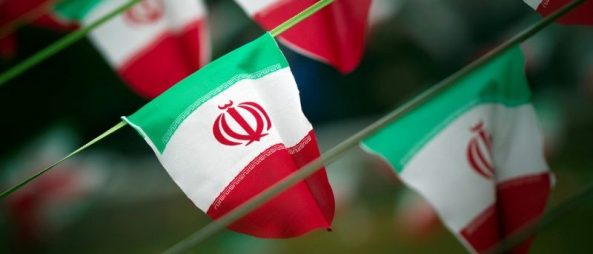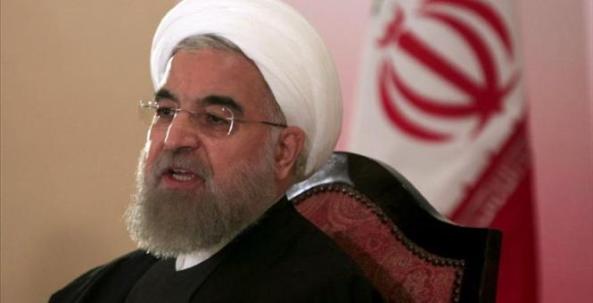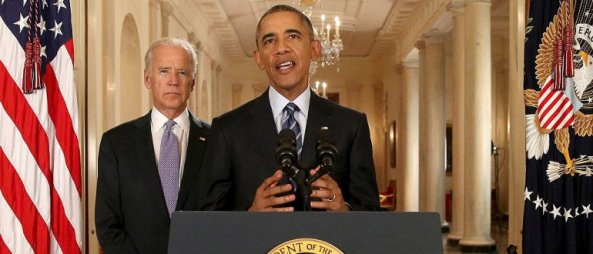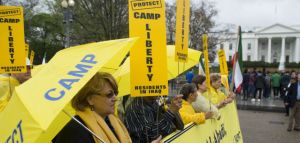Press Release
For Immediate Release
25 September 2012
CLICK HERE FOR ORIGINAL PRESS RELEASE ISSUED VIA PR NEWSWIRE.
Washington DC—On 21 September 2012, U.S. Secretary of State, Hillary Clinton, informed the Congress of her intent to remove an Iranian dissident group, the Mujahedeen-e-Khalq (MEK), from the Foreign Terrorist Organizations list. Upon publication in the Federal Register in about 7 days from her announcement, the delisting becomes official and all the consequences of sanctions embodied in the designation will also be lifted by different U.S. Government agencies.
Former Deputy Assistant Secretary of State for Environment in the Reagan and Bush administrations and member of the Advisory Board of the Iran Policy Committee, William A. Nitze stated,
 “I concur with Secretary Clinton’s announcement to delist the Mujahedeen-e-Khalq (MEK) as a long-overdue recognition that as the largest dissident organization in the Iranian parliament in exile—the National Council of Resistance of Iran—the MEK did not meet the statutory criteria necessary for terror tagging under U.S. law.
“I concur with Secretary Clinton’s announcement to delist the Mujahedeen-e-Khalq (MEK) as a long-overdue recognition that as the largest dissident organization in the Iranian parliament in exile—the National Council of Resistance of Iran—the MEK did not meet the statutory criteria necessary for terror tagging under U.S. law.
“The MEK only carried the terrorist label due to persistent lobbying by the Iranian regime and miscalculation by successive American presidents that concessions would appease Tehran’s clerical rulers and diminish state-sponsored proxy violence.”
Lt. Gen. Tom McInerney, (Ret), former Assistant Vice Chief of Staff, U.S. Air Force stated,
“Now that the terrorist tag has been removed from the Mujahedeen-e-Khalq (MEK) by Secretary Clinton, collection of dissident information as lead intelligence can accelerate and complement that of western intelligence services to bolster sanctions against Iran. Origins of international sanctions against Tehran came from blockbuster intelligence revelations of the MEK and the National Council of Resistance of Iran (NCRI), the parliament in exile of the Iranian resistance.”
Maj. Gen. Paul Vallely, (Ret), former Deputy Commanding General, U.S. Army, Pacific joined General McInerney in welcoming the announcement by Secretary Clinton and stated,
“As the guns of war with Iran are becoming louder for a post-American 2012 presidential elections conflict scenario, research of the Iran Policy Committee (IPC) suggests how important it is for the Washington to refrain from hamstringing the MEK with a terrorist designation. By delisting the organization, it can increase its role in facilitating political change in Iran.
“Delisting the MEK should jumpstart intelligence revelations at a critical time when such information can be useful in demonstrating Tehran’s propensity to cheat on its obligations to the United Nations and potential targeting of Iranian nuclear sites, if military force has to be used as an option of last resort.”
Captain Charles “Chuck” Nash, U.S. Navy (Ret) welcomed the Clinton announcement to remove the terrorist label on the MEK. Nash stated,
“Like other former military officers, I am very concerned about the exposure of unarmed civilian members of the Mujahedeen-e-Khalq (MEK) who suffer at the mercy of their jailers in Baghdad. Because of the pushback by Tehran against the removal of the MEK terrorist designation, its members in Iraq will be subject to recrimination. The Iranian press abounds with statements against delisting, perhaps prelude for Tehran to order Baghdad to launch a third assault on the MEK members like those in 2009 and 2011.”
Founder and President of Global Initiative for Democracy (GID) and former Freedom House Executive Director, Bruce McColm, said,
“With the delisting of MEK, which was the most distinct yardstick for the policy of appeasing Iran, the focus must now shift to assisting the Iranian people as they endeavor to bring down their oppressive rulers. The MEK can certainly play the role of the catalyst in utilizing its enormous political and organizational wherewithal to this end.”
Professor Raymond Tanter, President of the IPC and former member of the National Security Council staff in the Reagan-Bush administration said,
“It is encouraging that commitments made by the United State were reiterated on 29 August 2012, when Victoria Nuland, State Department Spokesperson, said the Department urges the Government of Iraq to continue steps to address humanitarian concerns raised at Camp Liberty by its residents [now some 3,000 members of the Mujahedeen-e-Khalq).”
Specifically, Nuland said,
“The United States…reiterates its commitment to work towards resolution of humanitarian issues at … [Liberty], including sustainable means for the continued supply of water and electricity. The United States also reiterates its commitment to support the safety and security of the residents throughout the process of their relocation outside of Iraq.”
“The United States will have to monitor implementation of such commitments,” stated Tanter.
Dr. Daniel Pipes, President of the Middle East Forum, has published over a dozen articles and given several interviews in multiple languages about the MEK, including on Iranian expatriate communities whose annual rallies in Paris are events attended by tens of thousands of supporters of the MEK. Concerning the announcement by Secretary Clinton to remove the MEK designation, Dr. Pipes stated, “A special vote of thanks to all those analysts, led by the indefatigable Raymond Tanter, who established that the MeK is not terrorist and that relations with it serve the national interests of the United States.”










